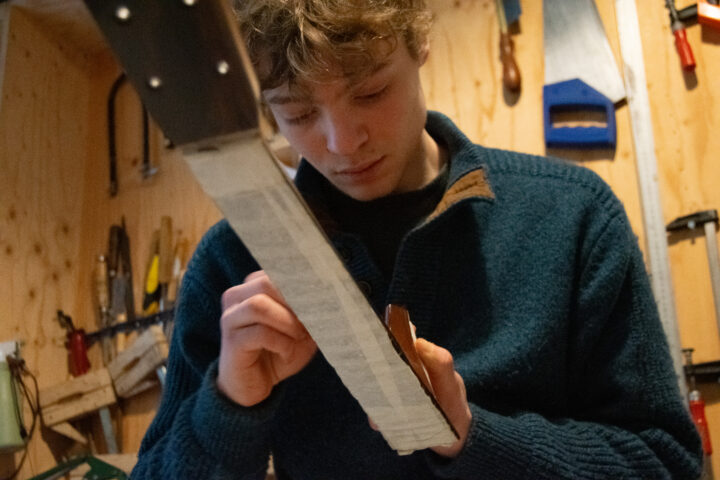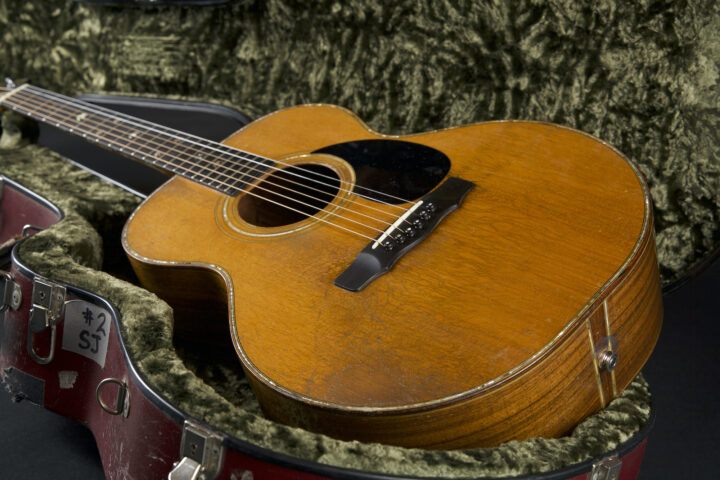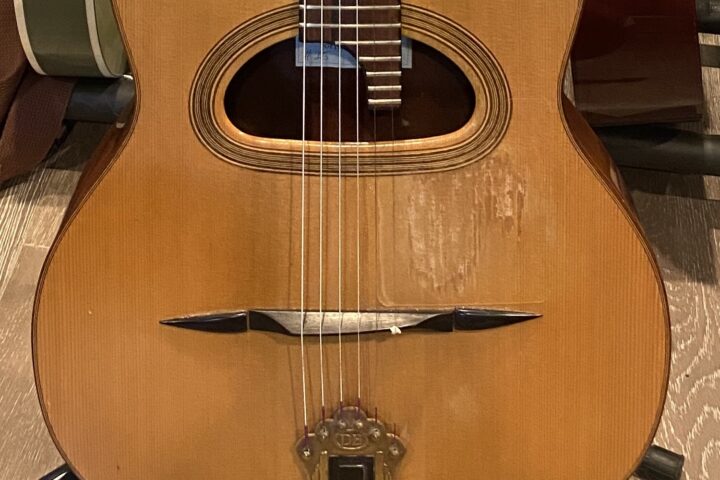Tubingen, Germany is a long way away from Nazareth, Pennsylvania. But it’s in Tubingen where you’ll find Rudolph Blazer and Wilhelm Henkes, two luthiers who are committed to building classic Martin (and Gibson) style guitars the way they were made in the 1930s. Like fellow luthiers TJ Thompson, Wayne Henderson and John Arnold, their exacting instruments are capable of impressing even the most discerning vintage acoustic guitar collectors. In this interview with Rudolph Blazer, we hear a bit about how they’re able to pull it off.
Fretboard Journal: How did your career in guitarmaking start?
Rudolph Blazer: I was born in Amsterdam. I didn’t finish high school and I was looking for things to do. My mother actually suggested that I become a guitar maker. So that’s what I did.
The only place to learn how to become a guitar maker was in Germany, in a little village called Bubenreuth. Framus and Hofner both come from Bubenreuth, which is this little town. And in this town, there are people working that originally came from Markneukirchen and Czechoslovakia. So, actually, they work in the same tradition as Christian Frederick Martin.
So I went there when I was 20 years-old and became a guitar maker. That’s the short version, of course.
FJ: And who did you originally work with when you were there?
RB: This was a classical guitar company called “Teller Guitars.” They were a company with maybe 20 guitar makers and some machinery. But very much like an American company would look like in the ’20s or ’30s, actually.
FJ: What was it that made your mom think you would be a good guitar maker? Was she a guitarist herself?
RB: No, not at all. I was born in ’51, and we started listening to the Beatles and Bob Dylan and all these great bands and musicians from the ’60s, of course. The next thing for me to do was start playing the guitar.
Then, of course, I was always fixing things and working with wood anyway. So my mother saw this and thought that would be good for me. I think she was right. And I think she especially liked the fact that this apprenticeship I could start was pretty far away from Amsterdam, so I’d see something new and do something on my own.
FJ: When did you leave the factory setting and set out on your own?
RB: An apprenticeship in Germany is usually three years of working for a factory, and, on the side, you would visit schools for bookkeeping and stuff like that. And, of course, the theoretical part of woodworking. But I was the first to start this kind of apprenticeship as a guitar maker in seven years. So there was not really a school for the theoretical stuff, which was fine with me. I ended up staying there for two years and did my examinations.
After two years, you pretty much see it all. And I actually was not into classical guitar making. I like steel string guitars; I always did. So that was my next goal, getting further into the steel string guitar making, which was not easy in Germany in the ’70s, because there were not many good guitars… there were not many Martins or Gibsons around. You would probably find those at the Army bases in Germany. I was lucky because when I left, I went to Stuttgart and got a job through a guitar maker, working for the American Army in one of the service clubs that they have on the bases. That’s where I met all these people that were into bluegrass and country music and rural American music. It was my next step.
FJ: Were you seeing interesting guitars from the servicemen?
RB: Sometimes they’d bring in their Gibsons. And there was a PX in Stuttgart that actually sold Gibson guitars. So they asked me to do the warranty stuff on them, which is what I did. I got to know the Gibsons from the ’70s there, which was not very inspiring, but it was interesting. And, of course, they had the Seventh Army Soldier’s Choir there, which means they had all the musicians in the Army. Most of them were there right at Kelley Barracks, where my craft shop was. So when they were practicing and rehearsing next door, it was great. I got to know them and had fun with them, hang out with them and play music. And I actually learned a lot about American music: it was like an education for me.
FJ: Blazer & Henkes are known for these exacting reproductions of the early Gibsons, Martins and Larson Brothers guitars. When did you actually get to have your hands on those instruments?
RB: When I was done working for the Army, a big shop came to me and wanted me to do repairs for them. So I resigned and got a small shop in the center of Stuttgart. Because it was right there, I met all these musicians. There was one collector who started buying a lot of American guitars then. So I got to do work on them. Actually this was the first time I saw old like pre-war Martin and Gibson guitars. This was very good for me!
Later, we started dealing with guitars. We started buying stuff from George Gruhn and John Bernunzio and guys like that.
I was playing in a bluegrass band then, and when you’re like playing guitar in a bluegrass band, you’re always looking for loud, strong guitars. Having my first D-18 — it was a ’37 — really opened my eyes. I said, “Wow, this is the best guitar I have ever heard or played!” That sort of changed my life as a guitar maker.
FJ: That’s fantastic.
RB: It’s absolutely true. And it was not easy. In those days, there weren’t many old guitars from America. So I was happy to have this experience and it absolutely blew my mind. So that’s when I decided I want to make guitars as good as possible and get as close to [the vintage models]. And that’s what we’ve been trying ever since. Then, of course, Willi [Henkes] came into the shop and started working first for me, and then with me. He has the same interest in old guitars. We sort of inspired each other. Everytime we would get a new guitar in from America — a wartime Gibson or an old OM from the ’30s — we would get down on our knees and be excited. That’s what inspires me these days, too.
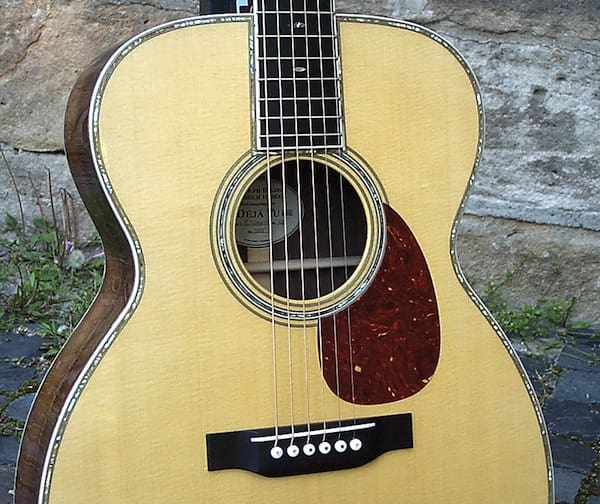
FJ: Are most of the people buying Blazer & Henkes guitars in Europe or in the U.S.?
RB: No, I think almost 90% of them are in the U.S. We have these two shops here in your country — one of them is Jim Baggett’s Mass Street Music in Lawrence, Kansas and the other one is Stu Cohen’s Music Emporium in Boston. Those two shops order guitars every year and sell them for us. And, of course, we have some direct customers, but these are our most important dealerships.
Then we have a dealer in Japan, called Blue-G. In Europe, we go direct, because it’s closer.
FJ: How many guitars do you make in a typical year?
RB: This year’s batch was like 25. Next year’s will be alike.
FJ: What’s your most popular model?
RB: It is a lot of D-18s and 28s, but then it’s also OMs. The way we make guitars, it really doesn’t matter so much what we make.
Our specialty is that build guitars like they did in the ’30s, right? So we use hide glue. We use a nitrocellulose finish. We use very light wood. And that makes them come out much like the ’30s, and I guess that’s what our customers really appreciate.
FJ: And where is your shop based these days?
RB: It’s in Tubingen, which is a small city full of students, south of Stuttgart. It’s very picturesque, Middle Age city. It just has a lot of nice old houses. We have an old shop in a house that is from 1550, I think. And we have like a beautiful shop with a lot of light.
FJ: Are you able to source spruce from nearby?
RB: Of course. Actually, what we really do from time-to-time, is go towards the Alps. Switzerland and Austria are two hours away. And right there you have the best source of spruce that you could wish for. Of course, everybody knows that for guitars, the tops are very, very important. So we do a lot of talking to the dealers we buy from. To us, it’s very important to know where the wood comes from and also at which time of year they cut the woods, which is almost a forgotten science. A spruce top or a spruce tree that is cut down at the wrong time of year would probably never sound as good as one that was cut down at the right time of year.
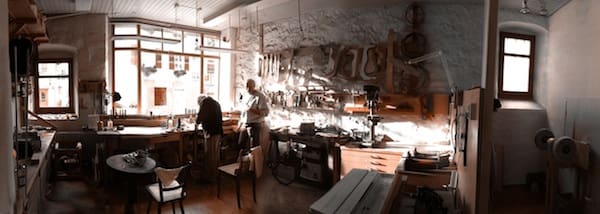
Blazer & Henkes workshop, photo by Eli West
FJ: When is the right time?
RB: The right time is definitely in the Fall. I’ve studied this a little bit, but I’m far from an expert. In the Alps where we go, there’s still a lot of tradition about wood cutting, which is very interesting. There’s this little museum that I once went to and they have examples of spruce and of what you can do with it. For instance, they have a chimney that, on the inside, is covered with spruce that was cut at a certain time of year and moon standing. You can make a fire in the chimney, but it won’t burn [down]! I think that’s very fascinating.
Then the same goes for if you built a bridge in the old days and you made it out of spruce, you’d choose the right time of year and stand of moon, again, and you’d gather the kind of spruce that would not rot and would not be slippery if you’d walk over it. They have pictures of a house that burned down, but the spruce planks they used to build the house are still standing — it didn’t burn!
So the same goes for tonewood: It’s late Fall. It’s not the highest trees that grow. It’s not right at the edge of the mountain, but it’s shortly before trees grow at all. Then again, it’s the guy who cuts it and knows when is the best time to cut them if you want to make guitar woods out of it.
FJ: You mentioned the moon cycle a few times. A few folks here know of “moon spruce.” It’s something that I don’t think any loggers in the U.S. are practicing. Can you explain a little bit about the position of the moon and how it may or may not affect wood?
RB: No. It’s definitely not a secret, but it’s a specialty. The first thing that is important for me is to talk to the guy who cuts the wood. He knows all about this. There’s also a calendar you can buy in Germany about this. An example is that if you go to the barber because you have your haircut, there’s a certain stand of moon which is good for it. It’s funny. I asked, “So, at certain days, barber shops are open till night?” And he said, “Yes, absolutely true.” In some of those villages, the barber shop stays open till 10:00 at night, because of this [calendar]!
One day we bought some spruce from a guy that we didn’t know, and it was a storage place in the village. So I asked him, “Can we move it to the other place to have it picked up?” He told me, “Yes, but let’s do it on Friday; it’s a better moon for this.”
Then I double-checked at another place where we had wood, and I told them, “Well, shall we do it on Friday, because that seems to be [better]?” They said, “Yeah, do it on Friday, because that’s the best stand of moon to do this.” So there must be truth in it.
FJ: If the guitar business dries up, you need to start exporting these calendars so we know when to get our hair cut over here!
RB: I can send you one! But this science is just forgotten in the United States. But if you search the Internet for the old European wood loggers from Germany or Austria or Sweden, they still knew about this. And back in the old days — and I think this is a significant difference between these days and before — in ’20s or ’30s, you had to go by these rules. There was no other way of cutting it, because you knew that if you cut it at the wrong time, there were no kilns and ovens to dry wood artificially, which is the worst thing to do for a guitar top, of course.
Another example is if you get Brazilian rosewood, they flood it — it would be flooded over the big rivers, right? The transportation was via [floating along] the river. And while doing this, the wood dries in a different way: it sort of bleeds out all the resins that’s in there, just having it [float] through the river. That’s another part of guitar making that is not very much attended, but I think it’s a very interesting and important part of it.
FJ: Let’s talk a little bit about finish. How do you finish your guitars?
RB: It’s a pure nitrocellulose. I think it’s the best finish for steel string guitars. So that’s what we do: we start the first coats and we end with the last coats, and all the way through it’s the nitro cellulous finish. It has a lot of more depth and polarization. It’s a whole lot of work to build up a finish like this, because it goes really into the wood, then after the first few coats we put a pore filler, and then we start building up the finish. On every guitar we make, there’s about a liter or a quarter of a gallon, I guess, of nitrocellulose on it. You spray your first coat, and then you spray the next one, and the next one is going to eat the first one. It’s going to react with it. So when it’s done, it’s going to be one piece of nitrocellulose finish, which is exactly what we want, and it’s really a part of the guitar, which is good for the sound.
Now for a modern kind of finish, you would first spray on a filler that’s usually made out of two components. If you spray on it again, it will not react to the first coat, which is essential because you can build it up real fast, but it’s not going to be part of the guitar like the nitrocellulose finish.
Nitrocellulose is a lot of work. You have to build up a whole thick coat of it and then you sand it down so you can polish it. So it’s a lot of sanding and then it’s a lot of buffing, and still you have to be careful because it’s not very hard. Then, it starts sinking in after a while. Our new guitars, after a few months, will have the look of an old-fashioned nitrocellulose finish. That is maybe a little unusual to people who are into modern guitars.
The finish is a big part of the guitar, and sound-wise it’s really, really important.
FJ: Have you always been this meticulous?
RB: Well, we had a chance to look inside a lot of old Martins and study them because of the repairs we have to do. And that sort of convinces you about what they did back then; it was completely right. This was a stitch in time for guitar making that was as good as ever. After that, it got different. The people now at Martin or the big factories have new machines; the suppliers of wood changed; and things had to be done faster. And there are not as many craftsmen at the big factories any more. So I think that’s a big change in guitars there.
It’s simply not possible these days to make guitars like they did in the ’30s on a larger scale. I’m convinced of this. So that’s what we try to do, which has a lot to do with finding out how they did it. It’s a science, actually.
FJ: In the 40 years that you’ve been doing this in Europe, have you discovered other steel string makers who are doing something similar to your work?
RB: Actually, no. We could not make a living on these guitars if we only sold them in Europe, which shows the importance of the steel string guitar [here], actually. There are not as many people that are into them, as in your country.
There are steel string guitar makers, but they do their own thing. They may be more like a Taylor guitar or another modern company. Which is strange, in a way, because many of these traditions that we are talking about, especially in the way we work and the materials we use, is still very European. There are still carpenters working with nitrocellulose finish. There are still carpenters working with hide glue. And there is, of course, a lot of machinery in Germany that you can buy and this tradition in making instruments, still, in towns like Markneukirchen.
I used to talk to the Martin guys in the ’70s when we were in the Frankfurt Fair, and they said their wholesale [distributor] for Germany sells as many guitars as one good shop in the United States. So we have focus on the United States, which is good because that’s where it all comes from — the great guitars and the beautiful music.

Willi Henkes and Rudi Blazer, photo by Eli West
